Healthy Everyday Rainbow Salad
on Jan 22, 2018, Updated Jul 24, 2024
This post may contain affiliate links.
I really couldn’t figure out what to call this salad. Superfood salad? Everyday salad? I landed on Everyday Rainbow Salad because a. you should aim to eat a big salad every day and b. this salad is bright and colourful, just like a rainbow. This salad recipe is more of a guideline for how to create your own rainbow salad. There are no rules here but rather a guide to the fruits and vegetables you can choose from each colour to create your own beautiful, superfood salad.
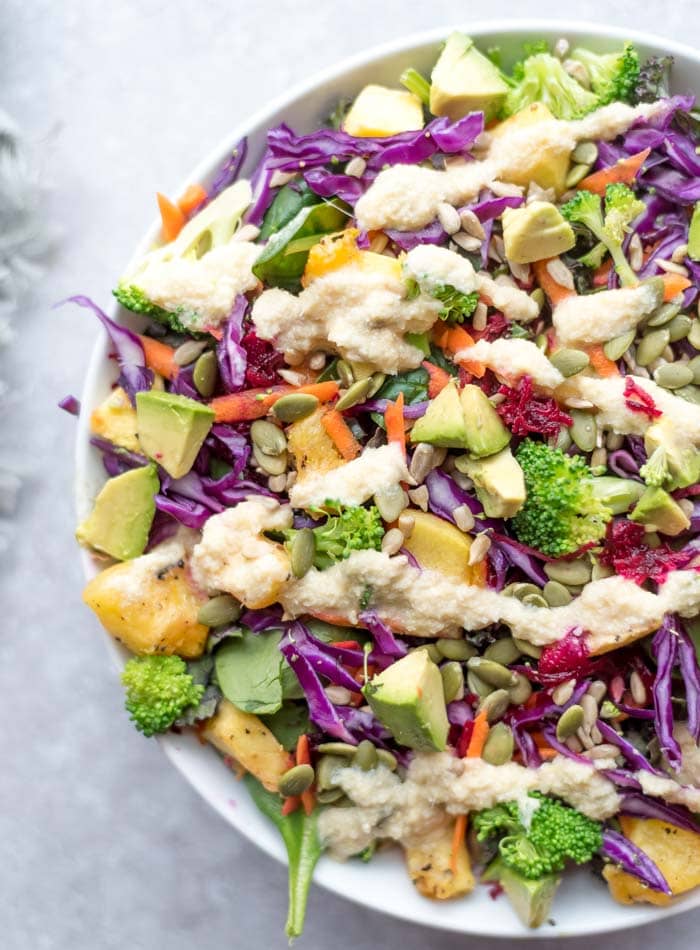
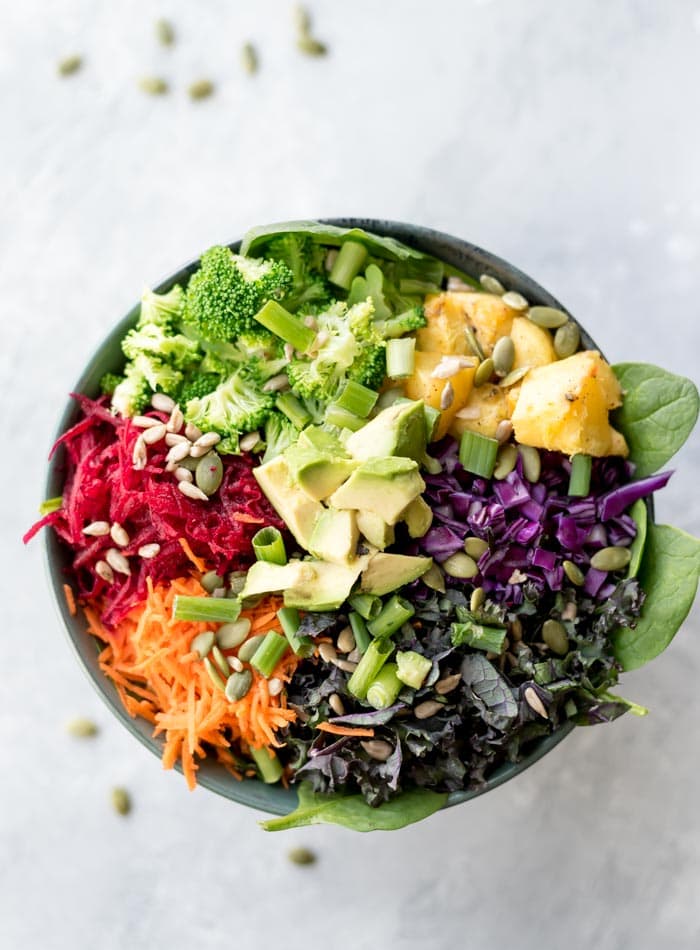
Why a Rainbow Salad?
By choosing foods from every colour of the rainbow, you maximize the number of different micronutrients you’re consuming. This is very important. Sometimes we can get stuck eating the same vegetables over and over again but it’s important to diversify what we’re eating to make sure we’re getting all the nutrients we need. Fruits and vegetables that are brightly coloured are rich in antioxidants that protect us from damaging free radicals and thereby help prevent disease, among other things.
Diversity in our diet is also important for our gut microbiome. The more robust and diverse the bacteria in our gut is, the better our digestion will be, which in turn means, the more our bodies can do with the food we’re eating and the better our overall health will be.
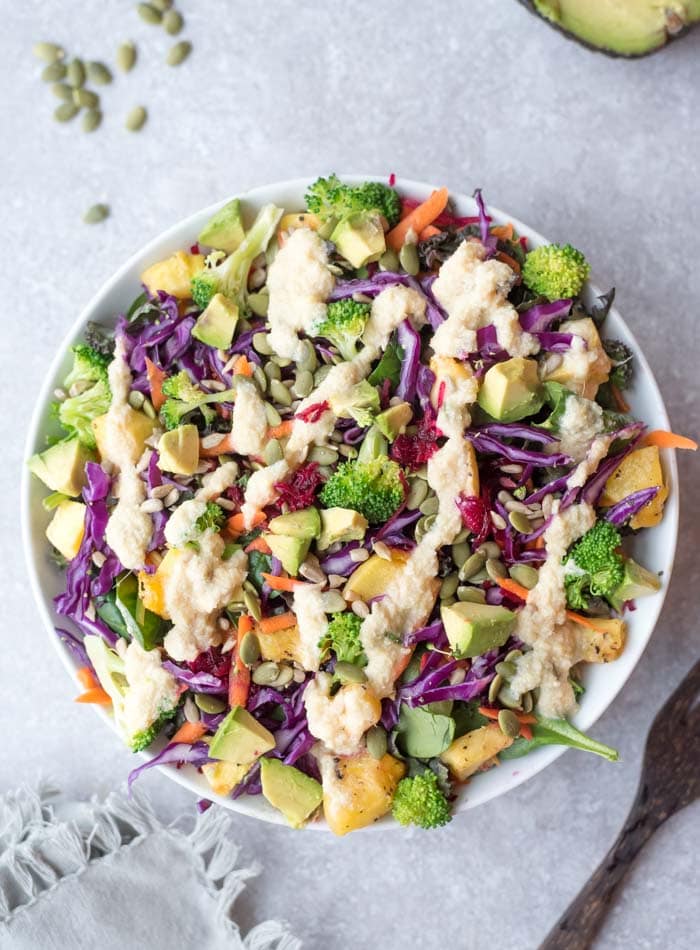
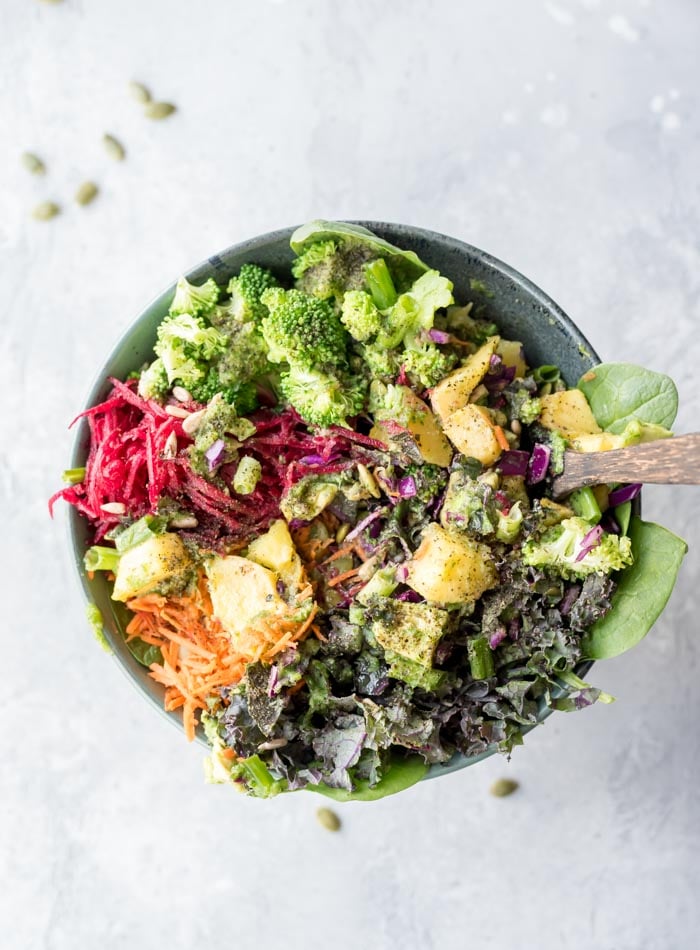
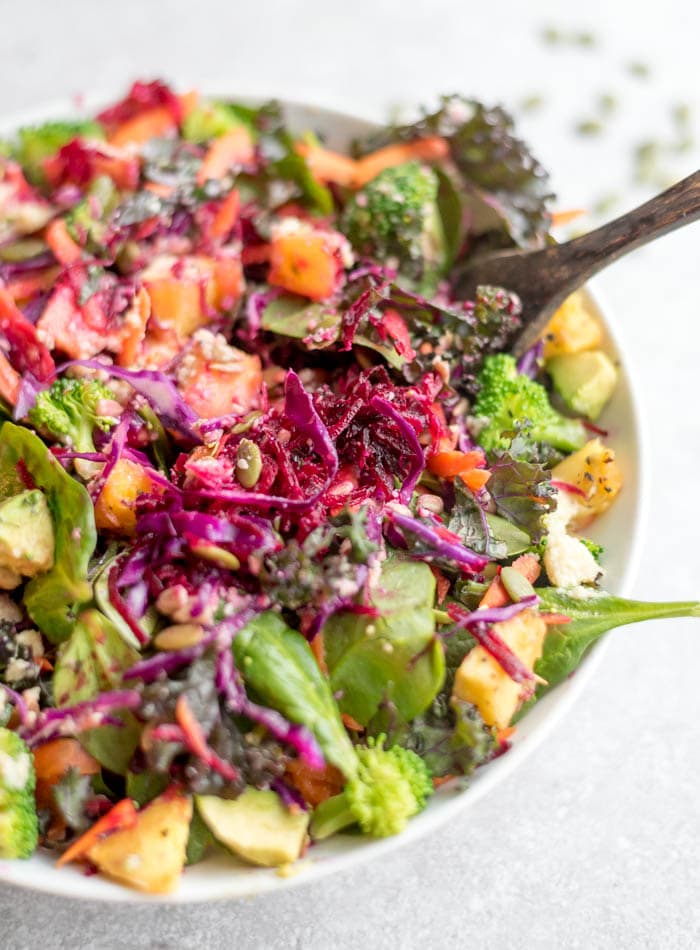
How to Make a Rainbow Salad
I’ve provided a rough guideline below for how to make a rainbow salad however, there really aren’t any rules. Pick and choose from the list, incorporating as many colours as possible. Try to mix it up with raw and cooked veggies, or choose all raw, and try not to pick all of the starchier vegetable such as squash and sweet potato.
Here are a few combos to get you started:
- raw and cooked salad: spinach, red pepper, red cabbage, roasted sweet potato, shaved brussel sprouts and sunflower seeds
- raw salad: kale, diced tomatoes, diced red onion, grated carrot, sliced cucumber, avocado, pumpkin seeds
- salad with grains: spinach, kale, grated beets, grated carrots, steamed broccoli, quinoa, walnuts
- salad with legumes: spinach, diced red, green and yellow peppers, black beans, roasted sweet potato
I didn’t put any white or neutral vegetable on this list but you can keep cauliflower, daikon, jicama and potato in mind too.
1. Choose a Dark, Leafy Green Base
For the base of your salad, you want to choose a dark, leafy green such as spinach, kale, swiss chard, collard greens or a combination of any of those or other greens. You can also choose mixed salad greens but I like the heartier greens like kale since they hold up better once they have dressing on.
- kale (red, green or black)</li)
- spinach
- swiss chard
- mesclun greens
- mustard greens
- red leaf lettuce
- collard greens
If you plan to eat your salad right away without leftovers, any greens work great though, if you plan to eat it the next day, I’d go with something like finely chopped kale or chard.
I used a mixture of spinach and kale for my base.
Nutritional Benefits of Dark, Leafy Greens
Leafy greens are nutrient-dense and one of the healthiest foods you can eat. They are a vital source of antioxidants, fibre and phytonutrients, help prevent disease, and promote healthy digestion, brain and heart health. Leafy, green veggies are rich in vitamins A, C, K and folate and minerals calcium, iron, potassium and magnesium. They’re also very low in calories so you can go ahead and load up to create low-calorie but filling and nutrient-rich meals.
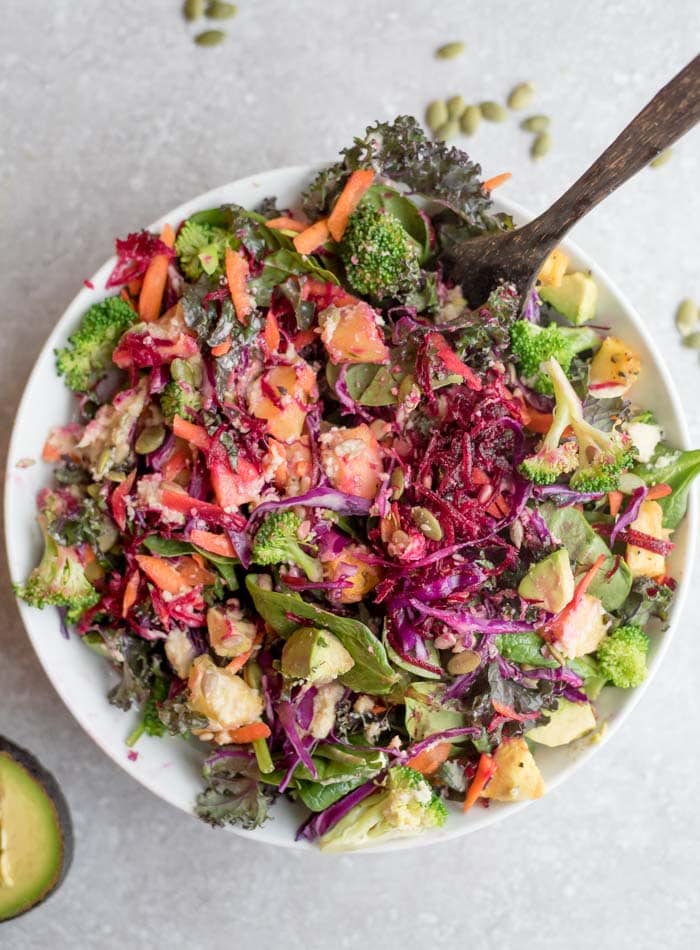
2. Chose 1-2 Red and Purple Vegetables
- diced tomato (sun-dried would be good too!)
- diced red pepper (or roasted red peppers)
- finely sliced radish
- raw grated, steamed or roasted beet (red, striped or golden)
- finely sliced raddichio
- finely sliced red cabbage
- roasted ube (purple yam)
- diced, finely sliced, pickled or roasted red onion
- purple carrots
I used raw grated beet and finely sliced red cabbage.
Nutritional Benefits of Red and Purple Vegetables
The phytonutrients that give red and purple vegetables their colour come along with powerful health benefits. Deeper, richer colours means the vegetables is rich in phytonutrients such as antioxidants, vitamins, and minerals and these nutrients have been shown to help prevent cancer, fight chronic illnesses, and strengthen the immune system.
Red vegetables get their colour from lycopene and anthocyanin. Lycopene is an important antioxidant that has been shown to reduce heart disease, promote healthy eyes and help fight infection. Anthocyanins, which are also found in purple vegetables such as purple cabbage, help protect the liver, reduce blood pressure and have anti-inflammatory properties.
3. Choose 1-2 Orange and Yellow Vegetables
- grated carrot
- diced orange bell pepper
- roasted, baked or steamed diced butternut squash
- roasted, baked or steamed kabocha squash
- roasted, baked or steamed diced sweet potato
- roasted, baked or steamed diced acorn acorn
- diced yellow bell pepper
- yellow summer squash
- grated golden beets
I used raw grated carrot and roasted acorn squash.
Nutritional Benefits of Orange and Yellow Vegetables
All these veggies offer their own unique nutritional profile but as a group, these brightly coloured veggies contain zeaxanthin, flavonoids, lycopene, potassium, vitamin C and beta-carotene. The nutrients help our bodies in many different ways, from reducing the risk of macular degenerations to protecting the bones.
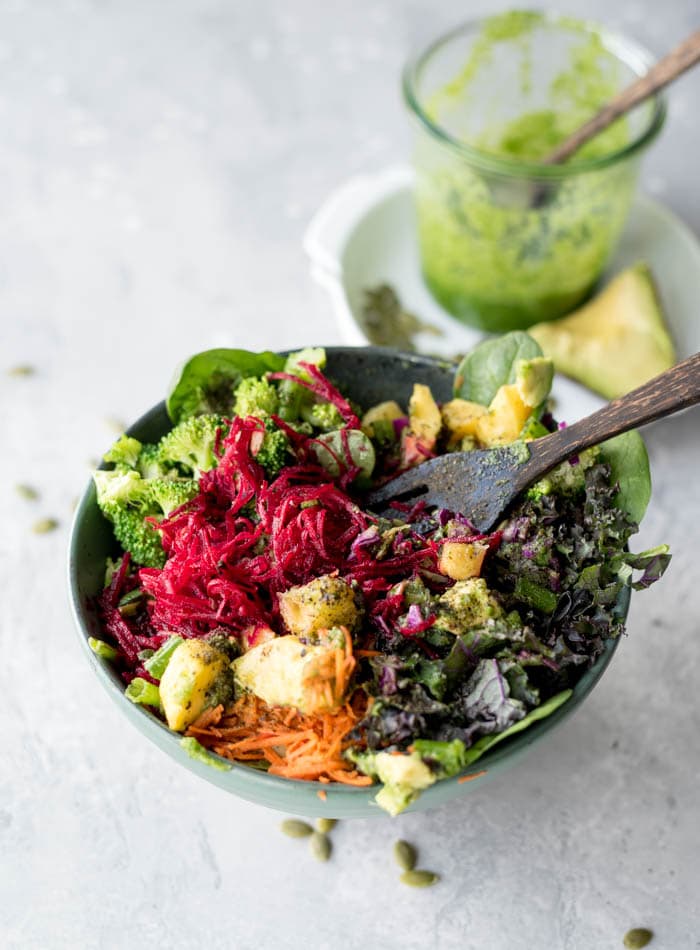
4. Choose 1-2 Green Vegetables
- raw, steamed or roasted broccoli
- diced green pepper
- diced cucumber
- diced zucchini
- snap peas
- any kind of sprouts (broccoli, alfalfa etc.)
- finely sliced or grated green cabbage
I used steamed broccoli.
Nutritional Benefits of Green Vegetables
Much like leafy greens, green vegetables are typically high in vitamin C and contain vitamin A, K, calcium, potassium and iron, and of course, are an excellent source of fibre. Cabbage, sprouts and broccoli are particularly nutrient-rich so try including those as often as possible, especially broccoli. The many nutrients found in green vegetables are important for a healthy immune system, cardiovascular health and disease prevention.
Besides all these general beenfits, every single fruit and vegetable offers it’s own specific nutrient profile, which is why eating a wide range of plants on a daily basis is so important to your overall health. The list of veggies I’ve provided isn’t exhaustive but includes the most common and readily available. There are so many more you can add to salads, think fennel, endive, fresh herbs, kohlrabi, turnip, artichoke and watercress, to name a few!
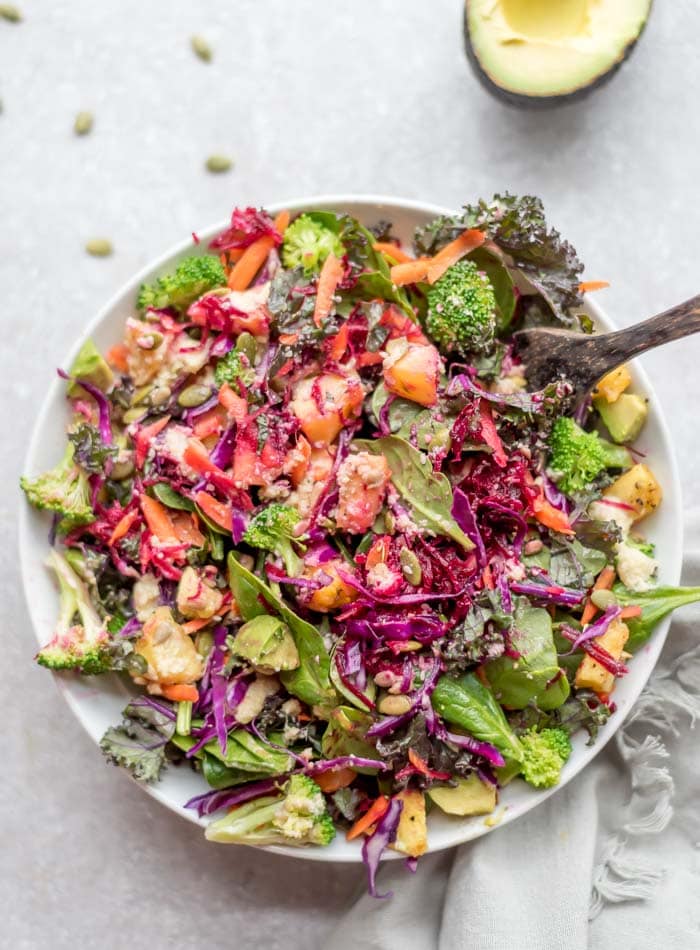
5. Add Healthy Fats
Add a mixture of 2-3 tbsp of nuts, seeds and/0r avocado:
- sunflower seeds, pumpkin seeds or sesame seeds
- nuts: walnuts, almonds, pecans, cashews
- hemp seeds or ground flax seeds
- diced avocado
I used 1 tbsp of sunflower seeds, 1 tbsp of pumpkin seeds and avocado.
Nutritional Benefits of Healthy Fats
Healthy fats are where you’re going to find your omega-3, 6 and 9 essential fatty acids, zinc, iron, protein, magnesium, vitamin E and other essential nutrients. It’s really important to get those omega-3s in particular since most people get far too many omega-6 fatty acids and come up short on omega-3. I talked about this a lot in my post on eating an anti-inflammatory diet.
Eating healthy fats helps keep your metabolism functioning, protects the brain, helps keep you full, helps keep blood sugar levels stable, reduces the risk of heart disease and cancer, helps lower cholesterol and more.
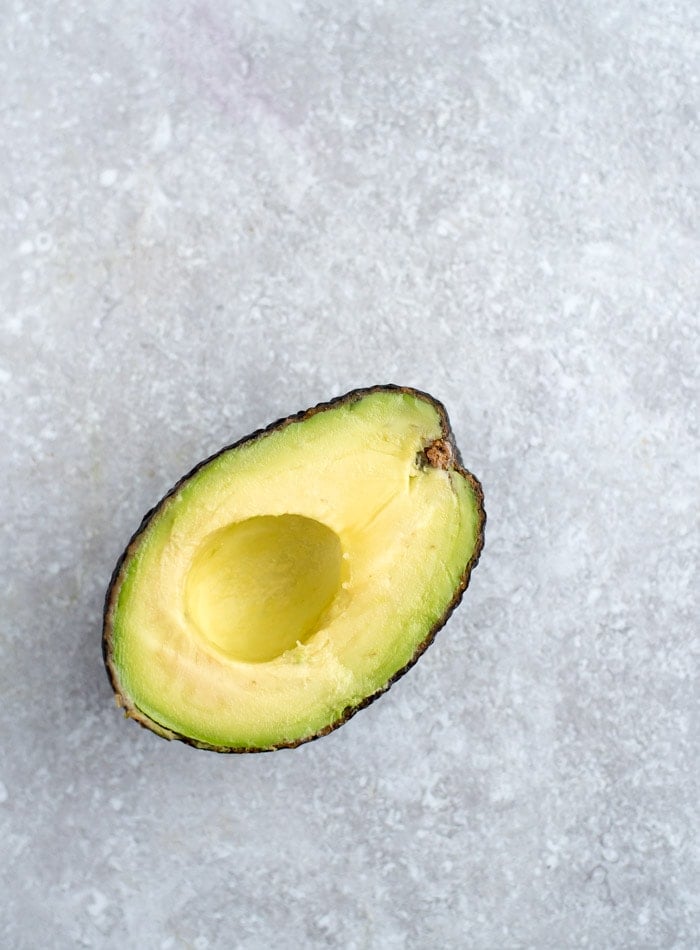
6. Optional: Add a Whole Grain and/or Legume.
Add up to 1/2 a cup whole grains and/or legumes to make it a more substantial and filling, higher-protein meal:
- quinoa
- farro
- brown rice
- millet
- black beans
- chickpeas
- lentils
- white kidney beans
Nutritional Benefits of Whole Grains
If you’re enjoy a rainbow salad for lunch and dinner, I’d suggest adding about 1/2 a cup of cooked whole grains. This will provide the energizing complex carbs you need for energy and some added protein. Whole grains are typically high in fibre, B vitamins such as thiamin, riboflavin, niacin and folate and minerals iron, magnesium and selenium.
Nutritional Benefits of Legumes and Beans
Beans and legumes are an excellent low-fat source of complex carbohydrates and protein. They’re typically high in iron, calcium, folate and magnesium and provide plenty of dietary fibre which is important for digestion, weight management, stable blood sugar levels and disease prevention.
7. Choose A Sea Vegetable.
A sea vegetable? What’s this all about? Sea vegetables are one of my favourite additions to salads, soups and even smoothies. There’s not much to them flavour-wise but they contain iodine which can be harder to come by on a vegan diet. Iodine is important for helping the body to create thyroid hormones which affect everything from metabolism to digestion, mood and immunity.
The only way we can get iodine is through out diet and unfortunately iodine deficiency is quite common today. Adding sea veggies to your diet is a great way to get that iodine in, in fact they’re one of the most nutritious foods we can eat and contain more vitamins and trace minerals per ounce than any other food. In addition to the iodine and individual benefits they offer, sea vegetables also have antibiotic and antibacterial properties, support healthy digestion and reduce cholesterol.
You can use kelp, nori or dulse for salads and other sea veggies include wakame, spirulina, chlorella and arame, which are great in soups and smoothies. I like dulse for salads since it doesn’t require cooking so you can just sprinkle it on top of your salad. Dulse is a good source of vitamin E, C and B.
I keep a container of dried kelp flakes on my counter and use it much like salt and it goes on just about everything I eat. This is also a great way to reduce your sodium intake.
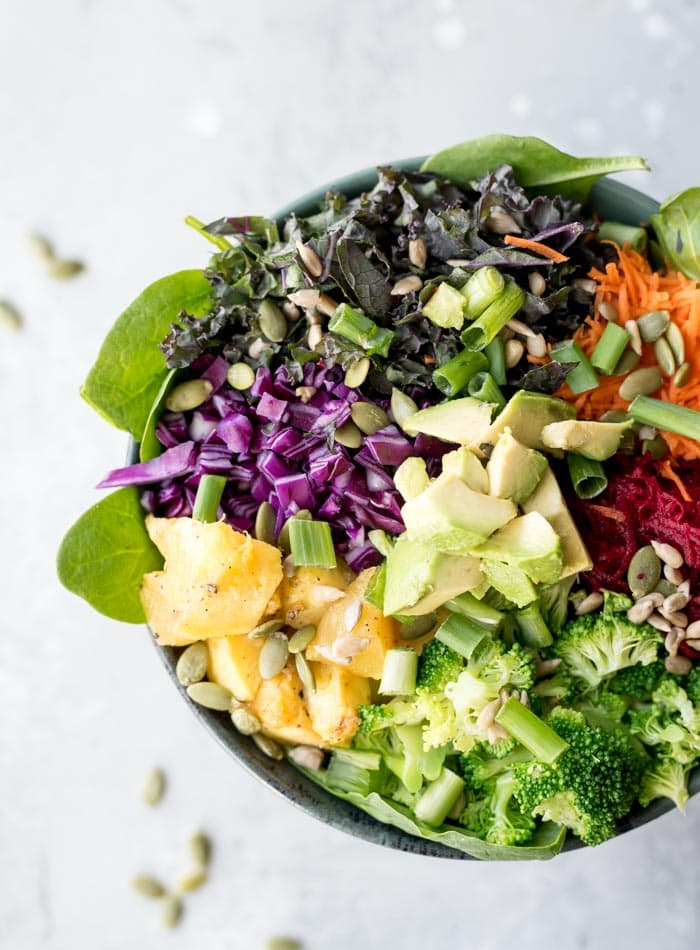
8. Make a Healthy Salad Dressing.
The dressing is the most fun part, don’t you think? There are so many choices! My favourite ingredients for creating your own salad dressings are:
- Fresh herbs. Cilantro, parsley, basil, mint.
- Tahini.
- Nut Butters. Peanut, cashew, almond.
- Vinegars. Rice, apple cider, balsamic.
- Fresh garlic, onion and ginger.
- Citrus. Lemon, lime, orange.
- Sea Salt and Black Pepper.
- Miso.
- Sweetener. Dates, maple syrup, stevia.
- Dijon Mustard.
- Spices and dried herbs. Cumin, chili powder, turmeric, onion powder.
- Soy sauce, tamari or coconut aminos.
- Nutritional yeast.
- Oils, on occasion. Flax, olive, avocado, sesame.
- Soft tofu or avocado.
If you’re stocked up on all of those ingredients, you can make endless variations of healthy salad dressings.
That’s about everything you’d ever need to create salad dressings from lemon miso, to creamy basil, to tahini maple, to lemon tahini, to orange ginger, to cilantro lime to balsamic vinaigrette and just about any other combination you can think of.
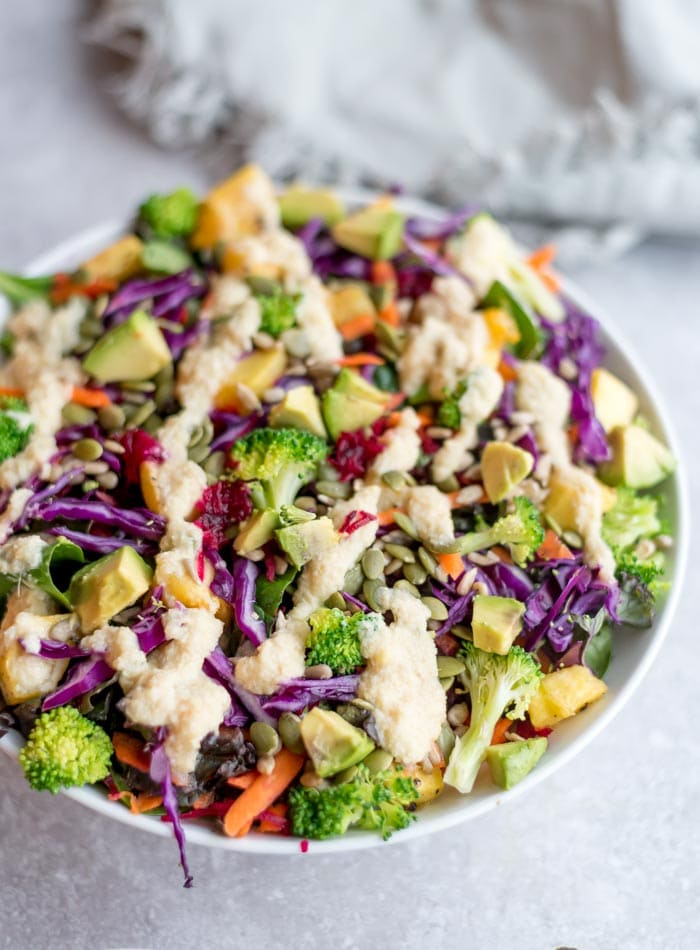
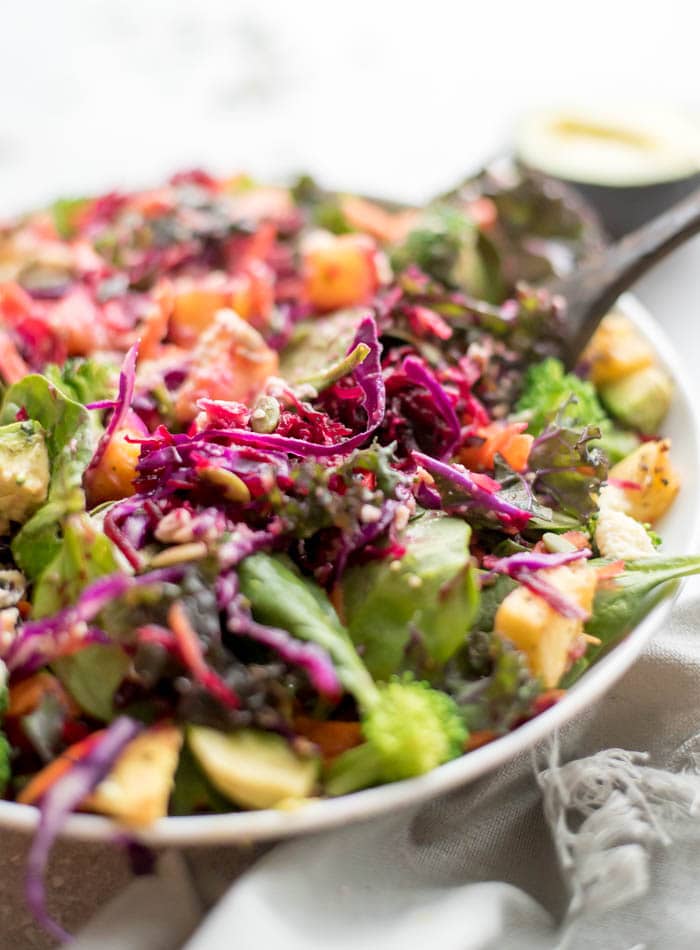
What About Fruits?
I don’t add fruits to my everyday salads that often but they do add a nice sweetness and their own host of nutritional benefits. If you want to add some colourful fruit, I would recommend:
- fresh berries such as blueberry, strawberry or blackberry
- chopped apple or pear
- chopped orange or grapefruit
- pomegranate
- sliced papaya or mango
- sliced peach or nectarine
- chopped kiwi
- chopped watermelon
I like adding fresh berries and sliced stone fruits like nectarine when they’re in season, otherwise, I’d say pomegranate, apple and pear are my favourites. I didn’t add any fruit to this salad but some chopped apple or blueberries would be awesome in there.
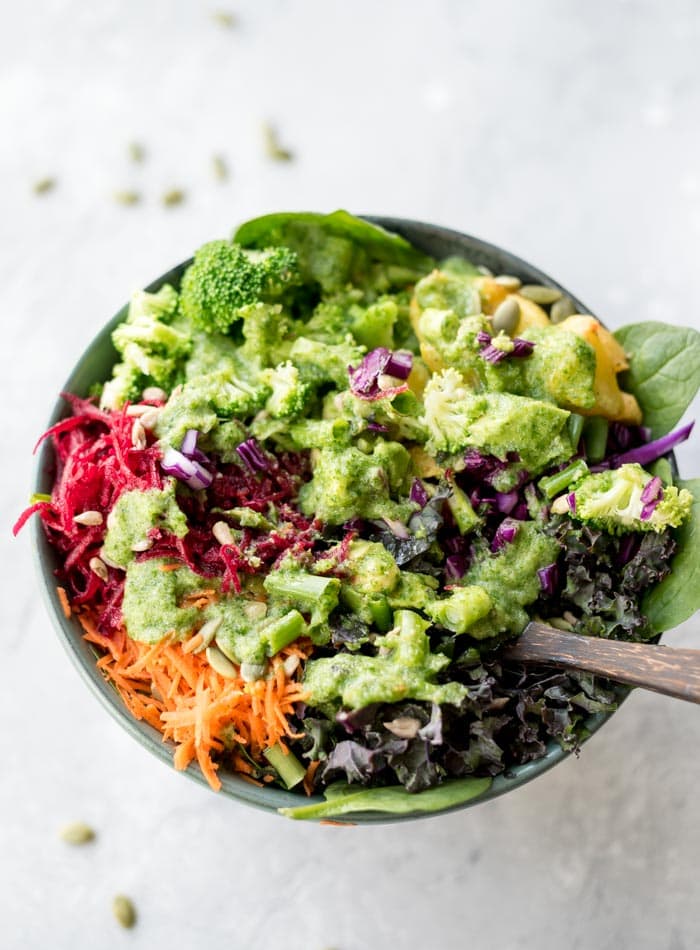
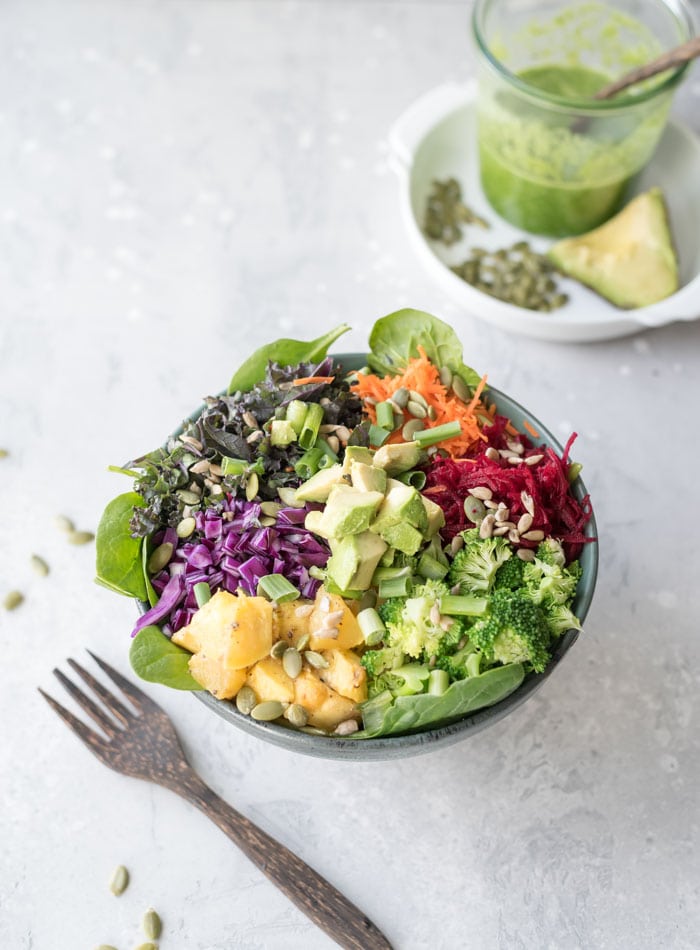
Healthy Everyday Rainbow Salad
Don’t be overwhelmed with all the choices I provided above. This guide to rainbow salad is just a reminder to build your everyday salads with lots of different colours and to get creative and have some fun with them.
I’ve provided a recipe below but it’s just one way to make your salad. When creating everyday salads, try using this rough guideline depending on your nutritional needs at the time:
Small side salad. Go all raw veggies + 1 serving of healthy fats + sea veggie + dressing.
Large side salad. Use raw veggies + 1 starchy cooked veggie + 1-2 servings of healthy fats + sea veggie + dressing.
Entree salad. Lots of raw veggies + 1-2 starchy cooked veggie + 2 servings of healthy fats + 1 serving grain and/or legume + sea veggie.
How to Food Prep for Rainbow Salads
To make these salads in minutes, I like to prep most of the ingredients ahead of time. That way I can mix and match ingredients all week for quick and easy meals.
For food prep, I would recommend grating beet and carrot, chopping up any raw veggies such as cabbage, broccoli and bell peppers, cooking whole grains such as brown rice or quinoa, baking some squash and/or sweet potato, having spinach and salad greens ready to go and making a few dressings.
More Healthy Salad Recipes
For more delicious, daily salads, try these too:
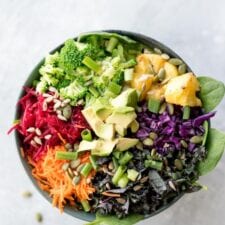
Healthy Everyday Rainbow Salad
Ingredients
Per Salad
- 1 big handfuls of fresh spinach
- 1 big handful of de-stemmed and finely chopped kale
- raw grated beet, about 1 small beet
- 1/2 cup finely chopped red cabbage
- 1/2 cup raw grated carrot, about 1 small carrot
- 1/2 cup peeled, chopped and roasted acorn squash
- 1/2 cup finely chopped, steamed broccoli
- 1 tbsp raw sunflower seeds
- 1 tbsp pepitas
- 1/4 of an avocado, diced
- dried kelp flakes
Miso Tahini Dressing (Serves 4)
- 5 tbsp 75 g tahini
- 1 tbsp 16 g white miso paste
- 1 tbsp soy sauce, coconut aminos or gluten-free tamari
- 1 tbsp apple cider vinegar
- 2 tsp maple syrup
- 3 cloves garlic
- pinch of salt
- 4 –6 tbsp water
Instructions
- To make the salad dressing, blend all ingredients until smooth. If desired, add more water to adjust consistency. Season with salt and pepper, if desired.
- To assemble the salad, add everything to a bowl and top with the dressing.
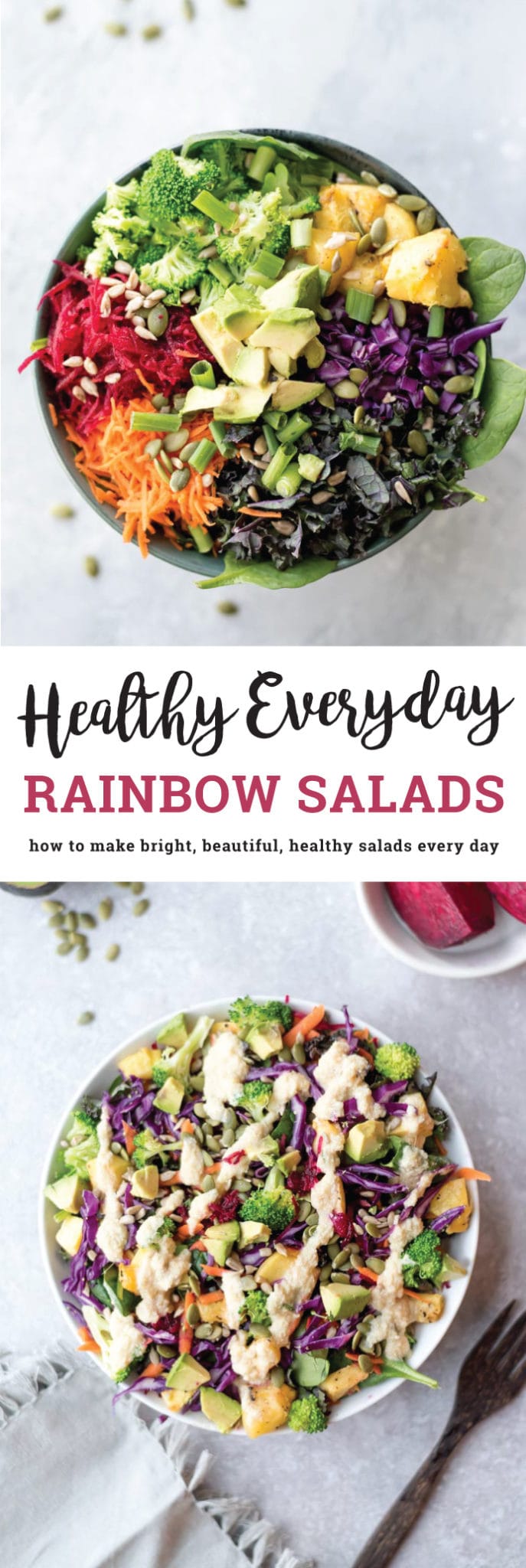
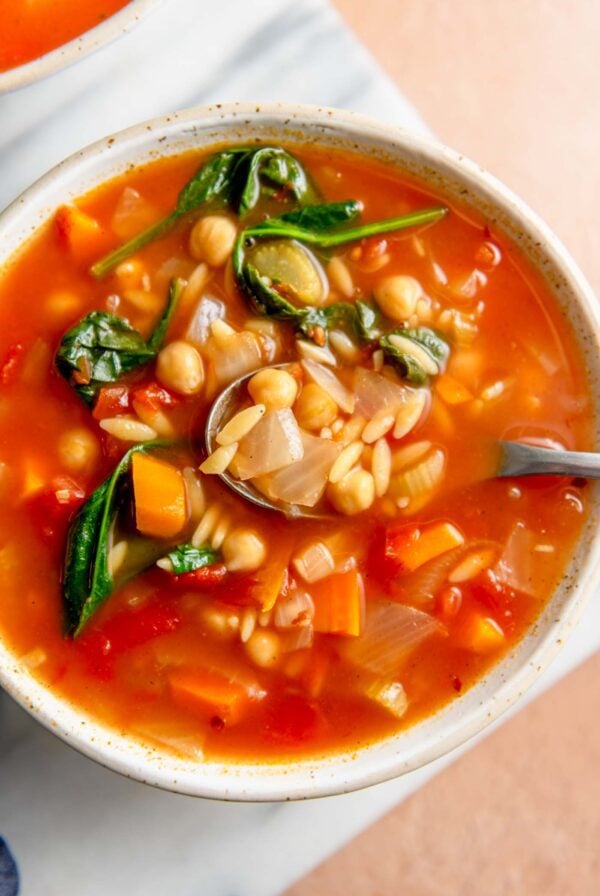
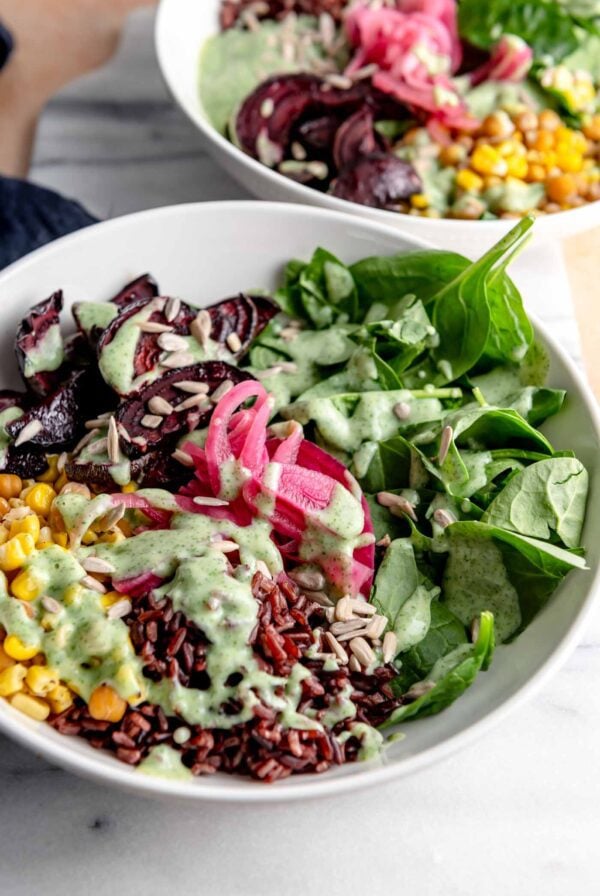
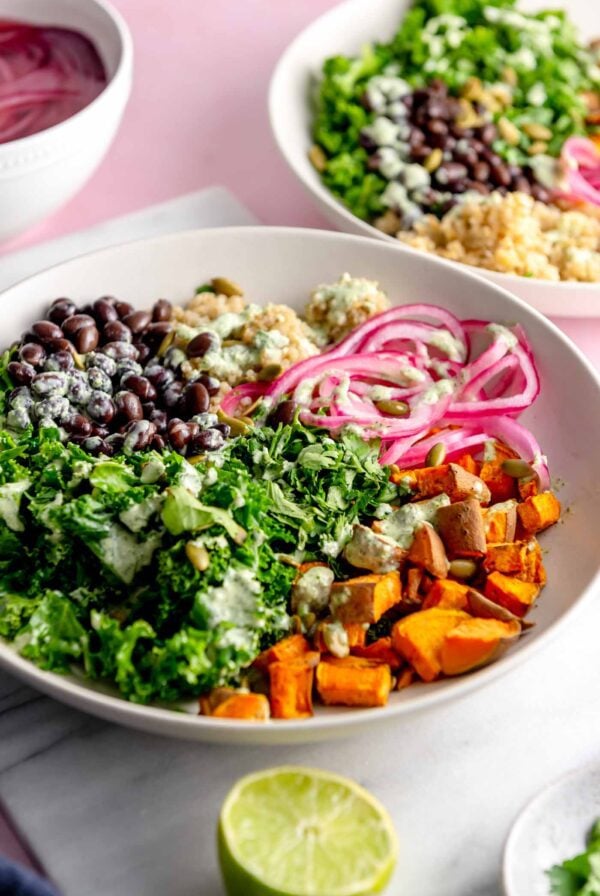
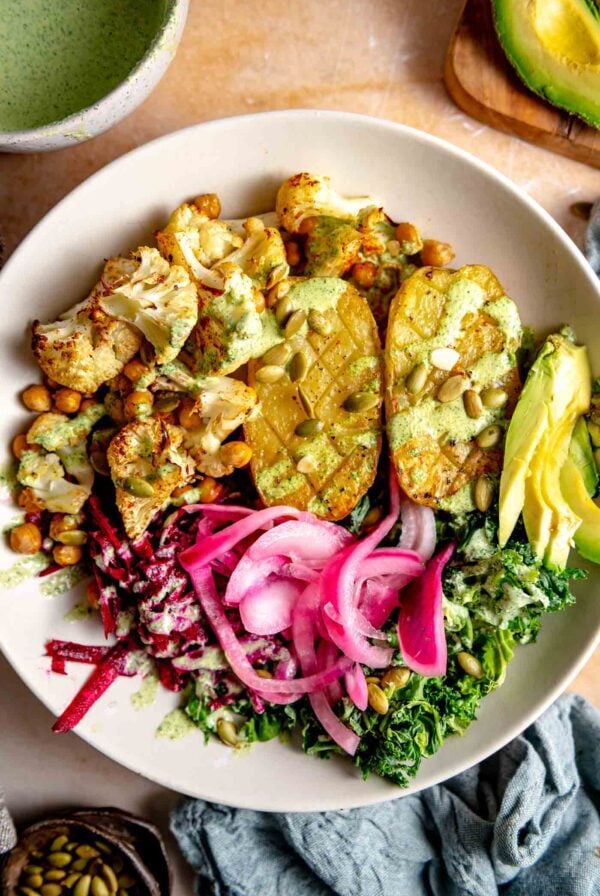








This guide has helped me to actually enjoy salads again! Thank you so much! ❤️
Wow! This Rainbow Salad is amazing!!! Every bite is a little surprise. I made it with all the ingredients in your recipe and the only change I made is I love my broccoli roasted so that is what I did. The tahini dressing is perfect with it. I look forward to trying your other dressings also but I don’t know, I like this one sooooo much!!! Thank you!
Thank you, Dana! Glad it was a hit.
This salad is delicious. The miso tahini dressing has become my new favorite and I’ve found it goes well with most salads. I love this recipe because it specifies how much for one salad and I’ve found that substituting different greens and veggies still turns out wonderful. Thank you for such an amazing salad and dressing recipe!
I’m so glad you enjoy it! Thanks for the feedback!
LOL. Googling to find more raw veggies to put in my weekly salad, and I find your site, where I found some great ideas for my own salad. I make it once a week. And yes, my salad easily lasts for a week, so long as I keep certain veggies out of the – the ones that go soft and mushy too early, like cucumbers, mushrooms, most sprouts, tomatoes,and certain delicate red lettuces, which are the ones in spring greens that start getting mushy around 8 days.
I shop at my local organic food store, then spend an hour chopping and slicing; leafy veggies chopped into ~1 inch pieces go in one huge bowl, and all the denser chopped veggies in another. I then pull out an 8 quart Tupperware container with air holes (advertised as veggie storage) and, reaching from the bowl of lettuce then the bowl of dense veggies, I layer the salad – leafy greens; dense veggies; leafy veggies; and so on, till the tupperware is stuffed full. I send any leftovers to my daughter, cuz I love her. 🙂
I put it in my refrig set to ~36 degrees, where it keeps fresh for 8+ days. Each day, I pull out the tupperware, open the lid, and, using my hand, dig deep till I’ve grabbed a large handful of two layers, putting 8 ounces into a large salad bowl. Because I chopped the leafy veggies into 1 inch squares, I get to use a tablespoon to toss large amounts of salad into my mouth, without the bad habit of clinking my fork against the bowl, getting an arched look from my more “proper” wife.
Leafy Veggies
Red Chard, one bunch
Dandelion greens, two bunches
Red Kale, one bunch
Beet greens, one bunch
Bulk mixed spring greens, 8 oz.
Bulk baby spinach, 6 oz.
Arugula, 4 oz.
Watercress, two plants
Dense chopped veggies
Broccolini, (baby broccoli), one bunch
Carrots, one bunch (6-7 medium)
One turnip
One rainbow radish
Brussels sprouts, 8
Red Cabbage, 1/2 small head
Red bell pepper, 1
green onions, two bunches
I usually top it with a can of tuna or salmon, or a three bean salad I make myself.
Thanks for letting me share. Friends say it’s a GREAT salad, but most believe the effort is too great. I believe their daily salad is the usual, spring greens with Ranch dressing. Uggghhh. Oh well, horses and water….
Scott Bagley
Thank you SOOOO much for these Rainbow Salad ideas. I’ve been looking for salad inspiration for ages and now I have it. BRILLIANT!
You’re welcome! Happy rainbow salad creating!
Thank you for this great informative post. We should all start our meals with a “rainbow salad”: very filling and packed with nothing but good ingredients. I myself make a simple miso dressing, but using white miso paste (along with rice vinegar and sesame oil), I find there is no need for any sweetener at all. I was recently visiting my children in the U.S. and was totally appalled by the omnipresence of sugar in one form or another in food. That is why I believe in homemade dishes, made from simple, unaltered ingredients. Getting rid of all additives has changed our life, especially my husband’s, whose health has dramatically improved with age!!!
Love it…so true.
Thanks for posting these great tasting oil-free dressings. I made the lemon tahini dressing and we used it as a dip for artichokes. My boys loved it!
That’s awesome, so glad you liked it!
I love me some salads and just got a new recipe to try next.
Thanks Deryn.
That looks so good! Thanks for sharing! I’ll have to try and make it sometime soon!
Yes, do it! Let me know what you create. 🙂
I am always looking for new salad ideas, as my husband and I love them. I love that you explain the health benefits as well. Thank you for the post!
Thank you for the comment!! Happy salad eating!